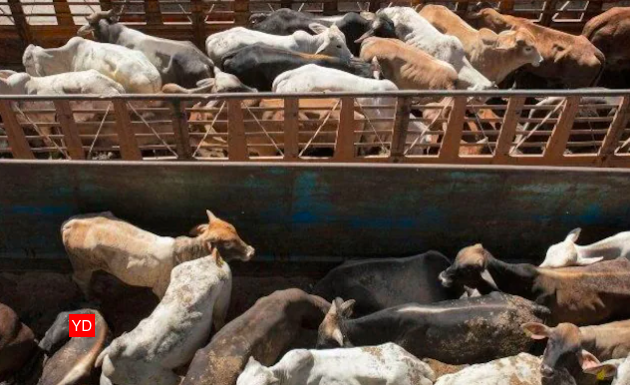Fodder prices in Rajasthan’s Hanumangarh district have risen many times over, forcing those who own animals that do not provide milk, or very little milk, to release their cattle to roam the streets. Similarly, those with milch cattle, they cannot feed have also started selling the animals they once cared for like family.
Hanumangarh has always been known as a bumper producer of wheat. Dry fodder made out of the remnants of the wheat crop is termed “tudi”. Of late, low production of wheat has resulted in the skyrocketing of tudi prices. This is because farmers opted to grow mustard instead of wheat due to the high rates it fetched last year. Therefore, in comparison to the 2,70,000 hectares of wheat planted last year, only 1,90,000 hectares of wheat was sown this year, whereas in the case of mustard, the land under cultivation rose from 1,35,000 hectares last year to 2,25,000 hectares this year.
Wheat was further affected by the countrywide heat wave in March 2022. Even as India witnessed the hottest March in 122 years, Rajasthan was one of the worst affected states with 25 heat waves and the highest number of heat wave days, with temperatures soaring past 40 degrees. This extreme climate adversely affected the crop, with grains being rendered very light and small. Thus, yields dropped from an average of 12 to 16 quintal per bigha to 6 to 9 quintals per bigha this year, which in turn affected tudi production, too.
Moreover, due to heightened demand, farmers are earning a lot more than the minimum support price of Rs 2,015 per quintal for their wheat, while prices prevail around Rs 2,100 to Rs 2,350 in the local agricultural markets (mandis). By the same token, the price of tudi has risen manifold.
“Last year, we bought tudi at Rs 200 per quintal. But this year, we cannot access tudi at even Rs 1,000 per quintal. Not just tudi, green fodder and animal feed are also very expensive this year,” pastoralist Bhola Singh of Sangaria told 101Reporters.
According to farmers, 1 bigha of land yields as much tudi as wheat. But this time, there’s been a drop in both wheat and tudi production, with the slump being as much as 40 per cent to 50 per cent. Not only has this made things difficult for those who rear cattle, but it’s posing a huge problem for the 220 gaushaalas (cow sheds) in the district. Owing to the high prices of fodder, farmers who normally donate fodder have ceased donations.
Lamenting the plight faced by dairy farms, Shri Goshala Seva Samiti (Hanumangarh) Chairman Indra Hisariya told 101Reporters: “We need nearly 15,000 quintals of tudi every year for our 2,300 cattle. But this year, we could only collect 6,000 quintals. There’s no means to collect the deficit fodder either. We’ll have to make do with what we have. By the time the crisis is over, it’ll be time for the next harvest, which will yield ample crop stubble.”
Ruing the restrictions imposed on bringing fodder from Haryana, Hisariya said that goshaalas in Nohar and Bhadra were facing a major problem.
Huge losses for pastoralists
“For a full-grown animal, one needs 10 kg of fodder per day. This means a daily expense of Rs 100. Green fodder and cattle feed are an additional expense. Pastoralism today is a losing prospect,” said pastoralist Bhola Singh.
“I have 18 cows and buffaloes. Of these, 11 animals yield milk, while seven are calves. I get 35 litres of milk from my buffaloes, and 15 litres from my cows, earning Rs 3,000 daily. I have to spend an average of Rs 200 on fodder, cattle feed and cotton seed husk per animal. With the prices of all these inputs having increased of late, I end up spending Rs 3,600, making losses.”
Pastoralists and dairy owners have raised the price of milk, with cow milk now selling at Rs 40 to Rs 45 a litre and buffalo milk priced at Rs 60 to Rs 65 a litre.
Dairy owner Vicki Bishnoi said: “Even at high prices, it is difficult to get tudi. I had to get it from Punjab at Rs 800 per quintal. But if you include the transport expense, it ended up costing me more than its price in Rajasthan.”
What caused the fodder crisis?
The primary reason behind the fodder crisis is the lower acreage under wheat. This has caused a shortage of fodder. To make matters worse, the Haryana government, has imposed restrictions on transporting fodder out of Sirsa and Hisar districts of the state.
Hanumangarh has a total of 8,65,000 milch animals that need 13.13 lakh metric tonnes of fodder annually. Normally, Hanumangarh supplies fodder to other districts of Rajasthan. But due to drought conditions prevailing in the districts of Barmer, Bikaner, Dungarpur, Jaisalmer, Jalore, Pali, Sirohi, Nagaur and Churu, there’s been a surge in the demand for fodder, with traders sending huge quantities of fodder there, bringing down stocks in Hanumangarh.
Agriculture Department Deputy Director (Extension) Danaram Godara says: “Farmers are also selling tudi to be transported to drought-hit districts, after keeping aside adequate stocks for their own animals.”
This has resulted in a big shortfall in the district, with animals in gaushaalas being the worst-affected.
Why have farmers opted out of growing wheat?
Explaining why farmers opted out of sowing wheat this year, farmer Raghuvir Singh from Lambi Dhav village told 101Reporters: “Last year, I had planted wheat on 10 bighas of land. But this year, the canals had very little water for irrigation. Meanwhile, mustard was fetching good prices. So I sowed mustard on 5 bighas, and wheat on another 5 bighas. The mustard crop was good, but the wheat crop was not. Anyway, I’m not complaining since in spite of not having to spend on fertiliser, pesticide or irrigation for my mustard, I could earn well from the crop. One has to spend a lot on wheat.”
Besides, while wheat fetched a little higher than the government’s MSP, mustard commanded a lot more. As against the MSP of Rs 5,050 per quintal fixed by the government, farmers sold their crop for Rs 7,250 to Rs 7,300 per quintal in the open market.
Administrative moves to tackle the crisis
District Collector Nathmal Didail recently organised a workshop, wherein 129 farmers pledged 168 bighas of land to grow green fodder for dairy farms. The Forest Department has also decided to grow green fodder on 100 bighas at the Kohla farm.
Limits have also been fixed to maintain fodder stocks; no trader can now stock more than 100 metric tonnes of fodder. Immediate relief to the tune of Rs 34 crore has also been announced to all 220 goshaalas in the district.
Meanwhile, Agriculture Technology Management Agency Project Director Balbir Khati has mooted the idea of growing azolla (duckweed fern) as an alternative fodder in every dairy farm. Easily propagated and highly nutritious, with just one hectare capable of yielding 70 to 80 tonnes, azolla is being viewed as the best solution possible.
(The author is a Hanumangarh-based freelance journalist and a member of 101Reporters, a pan-India network of grassroots reporters.)





Add Comment